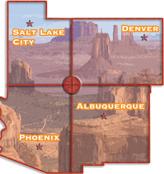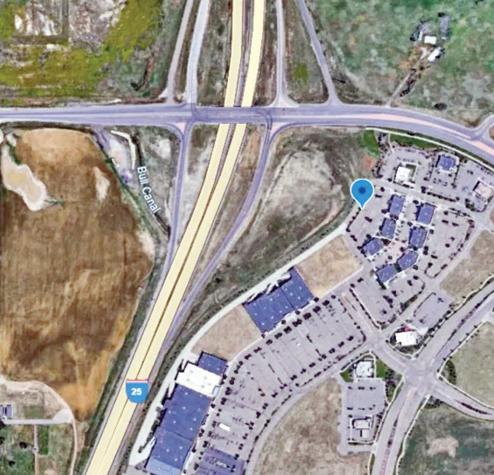




















By Irwin Rapoport
CORRESPONDENT
Granite Construction Co. is well on its way to delivering the Arizona Department of Transportation’s (ADOT) $171 million Interstate 10 Reconstruction between Ruthrauff and Ina roads project by December 2025.
The project is designed to improve safety and traffic flow between the two interchanges around northwestern Tucson.
Construction began in February 2023.
The project was combined with Pima County’s $34.95 million project to extend Sunset Road between I-10 and River Road, which was being constructed simultaneously.
The combined project includes 4 mi. of I-10 and 0.7 mi. of Sunset Road. It is financed by state, Federal Highway Administration (FHWA) and Pima County funds.
“This project will increase roadway capacity and improve operational efficiency of this portion of I-10,” said Garin Groff, an ADOT public information officer. “ADOT works with other jurisdictions frequently, including on local public agency projects.”
When completed, there will be five travel lanes in each direction — an increase of two — with auxiliary lanes between on-ramps and off-ramps.
Granite is reconstructing the existing traffic interchanges at Orange Grove Road and Sunset Road, which will be improved by constructing a new roadway over I-10 and the railroad at Sunset Road.
The I-10 main line profile will be raised at Canada del Oro Wash and Rillito Creek to provide sufficient floodway clearance.
Granite also is constructing new bridges to carry Sunset Road traffic over the Union Pacific Railroad (UPRR) and the Rillito River; replacing all nine bridges in the project area, including those over Canada del Oro Wash and Rillito River; constructing retaining walls throughout the project area; installing drainage and lighting; adding landscaping and other improvements; and placing an access path to the Chuck Huckelberry Loop from Sunset Road.

Pima County’s project is based on improving mobility in the vicinity of the I-10 Sunset Road interchange by connecting Sunset Road from I-10 to River Road.
The sections under construction experience heavy traffic, with some carrying 45,000 to 53,000 vehicles daily. The improvements will boost that to 88,000 to 101,000 vehicles.
The project’s first phase, which started in early 2023, shifted traffic to roughly 3 mi. of existing frontage road, providing three lanes of travel in each direction.
A second phase from April 2023 to March 2024 dealt with the reconstruction and widening of the main lines, the start of new bridges for I-10 and reconstruction of the Orange Grove Road interchange.
The third phase, which lasted from June 2024 to February
2025, dealt with the Orange Grove Tie-in, work on the Sunset Road interchange and construction on the Sunset Road extension to the east of I-10.
The project’s fourth phase, the Sunset Interchange/Sunset Links, began in February.
This work consists of building a new access to the interstate by extending Sunset Road east of I-10 to River Road. This involves building new bridges over the Union Pacific railroad tracks and the Rillito River. This extension will then connect to River Road, creating a new link to I-10 from the east.
The Sunset Road interchange is expected to open in conjunction with the project’s completion in late 2025.
Granite has encountered and overcome several hurdles.
see GRANITE page 3

Colorado Department of Transportation (CDOT) and representatives from the city of Thornton and city and county of Broomfield broke ground on May 21, 2025, on the fourth mobility hub on the Interstate 25 North corridor.
The facility will provide people in northern Colorado with additional transit options and connections across the state.
Mobility hubs provide multimodal connectivity by integrating safe pedestrian connection and waiting areas between modes.
“Today, as we celebrate the start of construction on the northern Front Range’s fourth mobility hub, we’re making Bustang and transit even more accessible,” said Sally Chafee, CDOT acting executive director. “These mobility

hubs are designed to make transit convenient, efficient and comfortable, offering people alternatives to sitting in traffic.”
Mobility hubs are designed to be strategically located and reduce a person’s reliance on their private vehicle, allowing them to easily and safely transition to another mode of transportation. The goal is to simplify travel, reduce wait times, improve safety, and make for a more pleasant travel experience.
When it is completed in fall 2026, the hub will provide a fourth location for people to not only access Bustang’s North Line but also connect to the local transit system between Boulder and Brighton along Colorado Highway 7. Three other CDOT mobility hubs are operating along I-25 to the north – at Firestone-Longmont, Berthoud and Centerra-Loveland.

“Initially, this hub will be able to accommodate 152 vehicles, with the ability to double its size to 304 vehicles,” said Jessica Myklebust, CDOT’s Region One transportation director. “It’ll also have slip ramps next to main I-25 ramps, allowing people to safely enter or exit the buses. Slip ramps also will allow Bustang to exit and reenter I-25 with minimal delay.”
Other improvements include:
Representatives of the Colorado Department of Transportation, the city of Thornton, the city and county of Broomfield, Adams County and the city of Brighton break ground on a new Interstate 25 mobility hub.
• a pedestrian bridge over I-25, providing safe access to the southbound ramp;
• bus shelters;
• new traffic signals at I-25/Colorado 7 ramps;
• additional sidewalks; and
• a permanent water quality pond.
“When the commission and CDOT decided to prioritize
state funds to develop mobility hubs, we knew we needed to have the necessary infrastructure in place to meet the transportation needs of the 21st century,” said Karen Stuart, Colorado Transportation commissioner “Our current mobility hubs, the one we’re breaking ground on today, and the ones we’re going to construct in the next several years, will play a critical role in shaping our transportation future.”
Mobility hubs are planned for Lone Tree, Castle Rock, Monument, Colorado Springs, Pueblo, Idaho Springs, Grand Junction and Fairplay.
(All photos courtesy of Colorado Department of Transportation.)
The largest wildlife overpass in Colorado is under construction across Interstate 25 in Douglas County, according to Colorado Public Radio.
The Colorado Department of Transportation (CDOT) said it will be one of the largest wildlife overpasses in the United States.
Kraemer North America is the project contractor.
Situated on I-25 between Monument and Larkspur, the $15 million Greenland Wildlife Overpass is designed to provide safe passage for large animals such as deer, elk and pronghorn over six traffic lanes, Colorado Public Radio reported. A federal grant provided most of the project’s funding.
The bridge, which is expected to be completed by year’s end, will be built with sloped entrances and covered in native grasses as an invitation for wildlife to use the crossing, according to Colorado Public Radio.
The overpass will span 209 ft. and will be
204 ft. wide, according to axios.com.
The overpass will connect 39,000 acres within the Douglas County Land Conservancy to more than 1 million acres of the Pike National Forest. Both are under long-standing conservation easements. It also will complete the wildlife crossing net-
work along I-25 from Monument to Castle Rock; the interstate bisects the largest protected open space along Colorado’s front range between Fort Collins and Pueblo.
Colorado has become a leader in constructing wildlife crossings, with more than 100 structures — including overpasses and

underpasses — present throughout the state, according to CDOT.
Only three of those existing wildlife crossings are overpasses, which are used by large animals who prefer clear sight lines from open structures. Larger animals don't often use underpasses, according to CDOT.
The overpass construction is part of the I25 Gap project that focuses on improving 18 mi. of I-25 from Castle Rock to Monument, largely by adding a toll lane in each direction.
CDOT expects the overpass, along with three other new wildlife crossings and 28 mi. of deer fencing, to reduce animal-vehicle collisions by 90 percent. The agency said there is an average of one animal-vehicle crash per day in the corridor.
About 85,000 daily trips are made on the impacted stretch that connects Denver and Colorado Springs, according to axios.com. That total is expected to reach 150,000 by 2040.
1
“One of the biggest challenges we faced early in the project was executing the traffic switches — particularly the transition from Phase 1 to Phase 2,” said Paul Preston, Granite's area manager. “According to the plans, we needed to shift 24 lane-miles of I10 traffic onto a newly constructed frontage road detour, all within an eight-hour overnight window. This involved obliterating old striping, restriping, placing raised pavement markers and installing new signage across 13 lane-miles — while keeping I-10 open to traffic the entire time. To manage this, our team came together and developed a phased approach.”
Bridgework also proved challenging.
The I-10 bridges with precast prestressed girders and concrete decks consist of the CDO Wash Bridge — 355 ft. long and three spans; the Orange Grove Bridge — 132 ft. long and one span; the Rillito River Bridge — 255 ft. long and three spans; and the Sunset Road Bridge — 218 ft. long and two spans.
The Sunset Bridges, based on a similar design, consist of the Union Pacific Railroad Bridge — 209 ft. long and one span along with steel girders, and the Rillito River Bridge — 377 ft. long and three spans.
“All the bridges in this project are being constructed using a consistent substructure approach, with some variations based on site-specific needs,” Preston said. “After demolishing the existing bridges, we prepared level drill pads for our drilled shaft foundation subcontractor. Each bridge is supported by drilled shaft foundations, with shaft diameters of 48 in., 60 in. or 70 in. and depths ranging from 74 to 104 ft. In total, we installed 121 shafts.
“Once the shafts were completed and approved, Granite constructed cast-in-place concrete columns — each 48 in. in diameter, with varying heights depending on the bridge. After the columns cured and reached design strength, we began forming the piers and abutments.
“To address flood risk, we used an EFCO form system for the piers, which bolts directly to the columns and is elevated above the riverbed. Once the piers and abutments were stripped and backfilled, the substructure was complete.”
The superstructure varies slightly between bridges that use precast concrete girders and those using steel girders.
“Our girder subcontractor mobilized cranes to set the girders,” Preston said. “For the precast concrete girder bridges, Granite forms the bridge deck using removable

Arizona Department of Transportation photo Subcontractor Ground Level tackles bridge demolition.
wood forms. For the steel girder bridges, our subcontractor installs permanent steel decking. Once the deck is formed and rebar is tied, we pour the deck using three concrete pumps. The surface is finished with a BidWell Concrete Paver and cured and textured using a cure bridge. After the deck reaches full strength, we install the approach slabs and armor joints. The final step is installing the barrier rail.”
Bridge construction crews used a BidWell concrete paver and work bridge, a Grove 90-ton crane, a Liebherr LTM14007.1 crane, a Manitowoc MLC300 VPCMAX lattice-boom crawler crane, manlifts and reachforks.
Bridge demolition was handled by Granite's DBE subcontractor, Ground Level.
“They used a combination of heavy equipment — including excavators equipped with shears and hammers, as well as a ball-and-chain setup — to safely bring down the existing structures,” Preston said.
“Once the bridges were on the ground, the materials were rubblized for removal and recycling. minimizing disruption to surrounding areas.”
Regarding drainage and underground infrastructure, crews are replacing and installing extended culverts and storm drains to facilitate the widening, accommodate new structure locations and support added weight.
“Facilities were constructed to collect surface draining on the north and southern sides of Ruthrauff Road. Flows on the southern side conveyed to the northern side at Highway Drive and the railroad abutment,” said Groff, “and then conveyed west toward the Santa Cruz River. They are constructing a closed roadway pavement drainage system.”
The I-10 roadway is mostly concrete surfaced except for the inside shoulders, which are asphalt. Sunset Road is asphalt. CEG










































The Utah Section of the American Society of Civil Engineers (ASCE) released the 2025 Report Card for Utah’s Infrastructure on May 29, 2025, assigning 12 categories of infrastructure a cumulative grade of ‘C+’, which is unchanged from the last report card in 2020.
Utah is one of only three states with a ‘C+’ grade, the highest grade ASCE has ever assigned to a state’s infrastructure. Only two other states, Georgia and Wisconsin, have ‘C+’ infrastructure grades.
Utah’s grade is one step higher than the national infrastructure grade of ‘C’ in the 2025 Report Card for America’s Infrastructure, which was released in March.
Utah’s aviation infrastructure was the only category to see a grade increase, while three categories (bridges, stormwater and transit) saw decreases. The remaining eight categories maintained the same grade as in 2020.
Roads received a B+, while bridges received a B and drinking water, solid waste and transit got B-. Aviation, dams and hazardous waste received a grade of C+, while stormwater and wastewater received a C. Trailing behind were canals with a D+ and levees with a D-.
“Utah is one of the fastest-growing states in the country, and state leaders have taken steps to ensure the reliability of infrastructure systems as more people move here to enjoy Utah’s thriving communities, amazing outdoors, and high quality of life,” said Craig Friant, chair of the 2025 Report Card for Utah’s Infrastructure. The investments in infrastructure that Utah leaders have prioritized have helped the state earn high grades
for roads and bridges. Roads received a ‘B+’ grade, which is significantly higher than the national ‘D+’. In 2023, state lawmakers approved the largest investment ever in Utah’s transportation funding, committing to more than $14 billion in upgrades and new construction over the next six years to help build or expand roads and highways in all parts of the state.
Utah’s bridges saw a one-step grade decrease to a ‘B’ in the 2025 report card, while higher than the national bridge grade of ‘C’ it is a sign that the data currently available indicates worsening conditions. In 2020, 38 percent of bridges in the state were in good condition, compared with 22 percent in 2024. While the state has worked diligently to prioritize preservation, rehabilitation and replacement of bridges, rapid increases in construction costs and an aging bridge inventory mean that existing funding levels can no longer support the number of bridge projects the state has historically supported.
As communities across the West deal with concerns about reliable water supplies due to ongoing drought and increased demand, Utah’s drinking water grade is unchanged at a ‘B-’. Utahns are doing their part to help preserve water supplies by reducing home water usage by 20 percent over the last two decades. However, existing water sources are facing additional stress due to regular drought conditions, decreased winter snowpack and the increasing number of people and businesses in Utah.
4Rivers Equipment has partnered with FAE to begin the sale and rent of PT dedicated tracked carriers in New Mexico and Colorado.
4Rivers Equipment will be the exclusive dealer of these machines in these areas, offering PT175, PT300 and PT550 dedicated mulchers.
Even as Utah contends with water shortages, the state’s dams, levees and canals are being tested by intense storms and flooding events. The grade for Utah’s dams remained a ‘C+’. Only 52 percent of Utah’s high-hazard potential dams are in satisfactory condition. It will take approximately $450 million in funding to bring all the state’s high-hazard potential dams up to satisfactory condition.
Utah’s levees received the lowest grade on the report card, a ‘D-’, the same grade as in 2020. These levees protect more than $13 billion worth of property and infrastructure, including densely populated communities and key facilities like Salt Lake City International Airport.
Utah’s canals, which received a ‘D+’ grade, are also part of the state’s flood management plan. Most canals were built in the 1800s for irrigation purposes, and since many of them are privately owned, there is limited information available on their condition.
Utah’s investment in aviation infrastructure helped increase the grade to a ‘C+’, which is a one-step increase from the 2020 report card. The new terminal at Salt Lake City International Airport has helped prepare Utah’s biggest airport for the future.
The report card was created as a public service to inform citizens and policymakers about the infrastructure needs in Utah. Civil engineers use their expertise and school report card-style letter grades to condense complicated data into an easy-to-understand analysis of Utah’s infrastructure network.
Metso’s distributor, ICM Solutions, has acquired the crushing business from Empire Southwest in Arizona.

“The innovation and efficiency provided by FAE’s equipment is another great offering for our customers to now take advantage of,” said John Shearer, CEO of 4Rivers Equipment. “We’re thrilled to have FAE as our working partner and look forward to our relationship.”
FAE is a designer and manufacturer of heads for tractors, excavators, skid steers, special vehicles and tracked carriers for forestry, agricultural and road work. FAE has a total of more than 90 products and 400 models.
4Rivers Equipment has been serving Colorado communities since 1926 and has expanded over the years to serve its customer base in New Mexico and Texas. With FAE’s establishment in the world of technological innovation for heavy equipment since 1989, 4Rivers has a new variety of equipment at its disposal for its diverse customer base.
“FAE offers optimal solutions for land clearing and construction,” said Daniel Bratton, 4Rivers Equipment’s general manager of construction and forestry. “It’s always a major boon to partner with a company that gives us new and exciting options for our customers to choose from.”
For more information, visit 4riversequipment.com/.
The acquisition expands ICM’s authorized distribution sales and service territory with Metso to include the entirety of Arizona, adding to its already existing footprint of Utah, southern Idaho, Nevada and northern California. This acquisition brings new opportunities for both ICM Solutions and the industrial, crushing and mining customers throughout the region.
This expansion follows ICM Solutions’ earlier move in April 2025, when they acquired Compass Equipment to enhance customer support across the western United States. That strategic collaboration marked a significant step in strengthening Metso’s distributor network, and the Arizona acquisition continues that momentum by extending further ICM’s reach and service capabilities.
tions and influence into the western United States,” said Steve Cianci, vice president of Americas Distribution Management. “This acquisition strengthens our partnership and enhances our ability to deliver exceptional service to our customers across a broader territory.”

“We are thrilled to see ICM Solutions’ continued investment and commitment to the Metso brand by expanding their opera-
“ICM is thrilled to add Arizona to its existing Metso territory,” said Scott Gardner, president of ICM. “We are committed to a seamless transition for Empire Southwest customers and will maintain the highest level of standards these customers have come to expect. This acquisition allows us to deepen our relationships with customers in Arizona and provide even greater value through ICM’s resources, expertise and dedication.”‘
For more information, visit metso.com.

Granite announced on July 8, 2025, that it was awarded a $111 million contract by the Utah Department of Transportation (UDOT) for a major infrastructure project in Salt Lake City.
And Granite said on July 16 that it was awarded a $17 million contract by UDOT for a bridge replacement project in Riverdale.
The Interstate 215-State Route 201 to North Temple project spans from milepost 19.53 to 22.8 and includes the rehabilitation of 3 mi. of I-215 and 12 miles of ramps for SR. 201, Interstate 80 and California Avenue, along with the rehabilitation of 22 bridges.
“This project is multifaceted, encompassing a diverse array of components that span strategic planning, creative development, stakeholder engagement and operational execution,” said Jason Klaumann, Granite vice president of regional operations. “It will keep Granite’s paving and structure crews busy through the winter and into the fall of 2026.”
Key elements of the project include:
• rubblizing existing Portland Cement Concrete Pavement and overlaying with 175,000 tons of highly modified hot mix
asphalt (HMHMA);
• structural deck replacements, hydro demolition and pothole patching across 22 bridges (18 deck replacements: 10 via hydro-demolition and eight standard remove and replace);
• installation of 22,000 linear ft. of storm drain; and
• ramp metering installation at California Avenue.
Construction is expected to begin in August and be completed in November 2026.
The Riverdale project involves replacing the 4400 South bridge over Interstate 15 and two Interstate 84 bridges over 4400 South constructed in the 1960s and now nearing the end of their service lives. The project area includes residential, commercial and public properties between Roy and Riverdale.
“To minimize traffic disruptions, the two I-84 bridges will be constructed adjacent to the existing structures and then slid into place during long weekend closures,” Klaumann said.
Construction was expected to begin in July and be completed by October 2026. For details, visit graniteconstruction.com.































